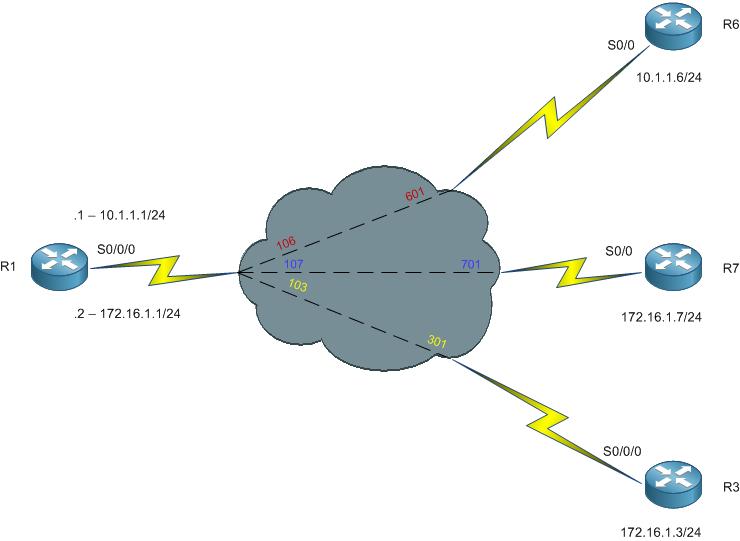Good morning!
Now that I am over the E3 2012 excitement (I wish I could rant about that here, but alas..), I finally found time to sit down and write some of what I am studying. Of course it's pretty basic stuff and I know that. It's just that I want to start from the absolute basics and build on it slowly, day by day.
So today, we're going to look at how we can configure a nice little frame-relay cloud for ourselves. I just got my 2522 router a while back and I bought this specifically to convert it into my frame relay cloud. This router is pretty handy; it has 10 serial ports, 1 AUI port (which can be converted into an Ethernet port by using a 10BaseT MAU transceiver). Very cool!
Here's the topology that we'll be working with:

The 'cloud' is my 2522 router and that's where we'll be sitting on for the entirety of this post. The connections are pretty straightfoward. I have a serial connection from the end routers to the 2522 router. R1's S0/0/0 goes to Serial1 of the 2522 router, R6's S0/0 goes to Serial6 and so on.
The first step is to enable frame relay switching.This is done by the global configuration command 'frame-relay switching'.
The frame-relay switch must act as the DCE end of the link. We need to specify this with the frame-relay intf-type dce interface command and then provide the clock rate as well using the clock rate <clock rate> interface command.
Next is to specify how the DLCIs are connected to each other. This is done using the frame-relay route route <inbound DLCI> interface <outbound interface> <outbound DLCI>. This is telling the switch that the other end of 'X' DLCI is 'Y' DLCI. It essentially binds the outgoing interface and the two DLCIs together into a virtual circuit.
Also, don't forget to set the encapsulation of the interface to frame-relay using the encapsulation frame-relay interface command. That should be the first step without which you won't see any of the frame-relay commands under the interface:
FRSwitch(config)#interface Serial 1
FRSwitch(config-if)#frame-relay?
% Unrecognized command
So, at the end of the day, our four serial interfaces on the 2522 should look like this:
FRSwitch#show running-config interface serial 1
Building configuration...
Current configuration : 246 bytes
!
interface Serial1
no ip address
encapsulation frame-relay
clockrate 56000
frame-relay intf-type dce
frame-relay route 103 interface Serial3 301
frame-relay route 106 interface Serial6 601
frame-relay route 107 interface Serial7 701
end
FRSwitch#show running-config interface serial 6
Building configuration...
Current configuration : 156 bytes
!
interface Serial6
no ip address
encapsulation frame-relay
clockrate 56000
frame-relay intf-type dce
frame-relay route 601 interface Serial1 106
end
FRSwitch#show running-config interface serial 7
Building configuration...
Current configuration : 156 bytes
!
interface Serial7
no ip address
encapsulation frame-relay
clockrate 56000
frame-relay intf-type dce
frame-relay route 701 interface Serial1 107
end
FRSwitch#show running-config interface serial 3
Building configuration...
Current configuration : 156 bytes
!
interface Serial3
no ip address
encapsulation frame-relay
clockrate 56000
frame-relay intf-type dce
frame-relay route 301 interface Serial1 103
end
That's pretty much it. We have our 'cloud' set up. All we need to do now is to configure the end routers and blow some things up Again, I know this is pretty basic but we'll be using the above configuration to dive deeper into how frame-relay works along with some general frame-relay troubleshooting in my next post (let's hope we don't have to wait till E3 2013 for that ).
I hope this was informative.
